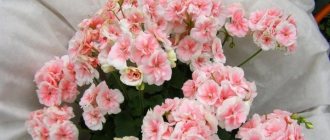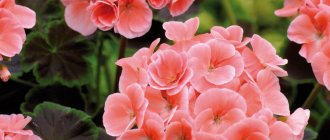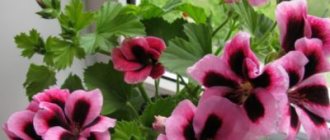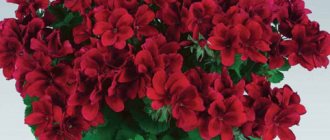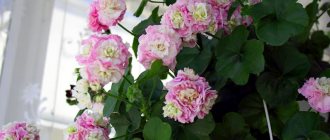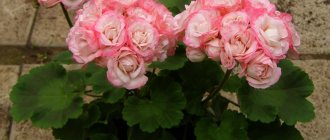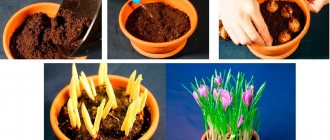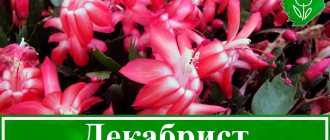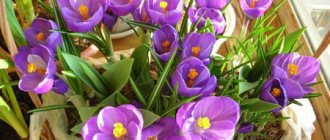How to propagate
There are two ways to propagate Simon group pelargoniums: cuttings and seeds. In the first case, all varietal characteristics of the mother bush are preserved, in the second, the grower receives completely new plants.
Cuttings
Many beautiful pelargoniums of this variety are hybrids, which means they can only be propagated at home by cuttings.
We plant cuttings like this:
- after trimming the bush, select shoots suitable for planting;
- cut them at a 45 degree angle;
- wait a while until the cut is covered with a film - it stops releasing juice and becomes dull;
- plant the cuttings in plastic cups filled with pre-sterilized moist soil;
- leave the plants to take root in a shaded place until the first leaves appear;
- After the greenery appears, take the plants to a bright place without direct sunlight.
Seeds
Representatives of "Salmon", which are not hybrids, grow well from seeds, retaining all the original characteristics of their variety.
Plant the seeds as follows:
- Pre-wet the seeds in water or rub with sandpaper - this will help the sprouts hatch faster;
- place the sterilized soil in a container;
- we plant the seeds at a distance of 3-5 cm from each other in moist soil;
- gently crush each seed with your finger;
- cover with a thin layer of soil;
- cover the container with film and transfer to a dark place;
- after germination, we bring the plants into the light;
- every day we peel back the film to ventilate the seedlings;
- if the ground is wet, there is no need to spray the soil - waterlogging can lead to the death of crops, as can irregular watering;
- With the appearance of the first two true leaves, the sprouts are transplanted into individual cups.
Be attentive to these wonderful plants, and they will thank you with lush and beautiful flowering.
Landing rules
Planting activities should be carried out in mid-April or early May . At this time, the earth will already be completely warmed up. It is better to purchase planting material in specialized stores, because this is the only way to be sure of the quality of the products. Pelargonium Salmon seeds are quite large, so before planting, lightly rub them with fine sandpaper. This will be their scarification.
The planting process has its own characteristics:
- Prepare a wooden box and fill it with nutrient soil. The store-bought option is perfect for these purposes.
- Make grooves, placing them at a distance of 2-3 cm.
- Distribute the seeds maintaining a distance of 1.5 cm, lowering them to a depth of 1 cm. There is no need to sprinkle with soil, but simply cover the seedlings with film.
- They appear on days 14-20. And as soon as they form 2 leaves, they can be transplanted into containers with a diameter of up to 10 cm. The soil can be used the same as for growing seedlings.
- Pour soil up to the edges of the pot and make a depression in the center. When planting seedlings freely, it is much easier and more convenient to handle the plant.
Description of varieties
Among the varieties of pelargonium of the Elnaruds series, there are the most common ones.
Hilda
Compact pelargonium with lush double buds of uneven pink and white color. The leaves are yellow with a brown spot in the middle. Hilda tolerates heat well and has a long flowering period.
Pelargonium anita (anita)
Gusten
A vigorously flowering variety of pelargonium Elnaryds. The inflorescences are dense, the buds are peachy-pink. The bush has a compact shape.
Variety Gusten
Bente
Zonal pelargonium. It reaches a height of 10 cm. The inflorescences are lush and double. The buds are apricot-red. Flowering of this species begins in May and continues until the end of September.
Bente flower
Otto
Otto is often used to decorate balconies and verandas. The buds of this variety are orange in color, gradually turning into soft pink. The bush reaches a height of 10 cm. Flowering begins in late spring.
A variety of flower called Otto
Names of flowers for creating a balcony flower garden photo
Singoalla
House plant with white, slightly pinkish flowers. The bush is compact and easy to shape.
Pelargonium Singoalla
Lilian
A dwarf plant with double voluminous inflorescences. The buds can be bluish-lavender in spring and pink in summer.
Representative of the Lilian variety
Clarissa
Lush bush with snow-white double flowers. The plant is compact and does not require formation.
Clarissa flower
How to plant, care for and propagate April Snow pelargonium? possible pests and diseases
Peculiarities
Pelargoniums have certain features that relate to their development cycle and maintenance conditions. There are several such moments:
- All varieties are characterized by long flowering. Sometimes inflorescences appear all year round with short breaks.
- These flowers do not need spraying at all and, moreover, they are contraindicated. Due to the pubescence of the leaf plate, moisture is retained on its surface, which can lead to its rotting.
- A period of rest is necessary for full development. It occurs in the winter and requires compliance with certain conditions of detention at this time.
- Plants tolerate pruning well, which allows plants to be shaped and given a compact and attractive shape.
It is also worth noting that pelargoniums can be planted in the ground in the summer. This has a very beneficial effect on the appearance of plants and flowering activity.
Attention! These plants are not afraid of cold nights and are not particularly sensitive to climate changes. This is what allows them to grow quietly in open ground in the summer.
Appearance and characteristics of pelargoniums
There are about 250 varieties of Pelargonium Toscana. The most favorite plants of gardeners are Bernd pelargonium, Regina species, Tammo and others.
The stem of the flower can be straight or curly, and the leaves can be carved and terry. But the defining characteristic feature is the inflorescences themselves - bright or soft pink flowers of 4 petals, which are collected together into a bouquet.
Royal pelargonium is valued for the unusual color of its semi-double petals.
This is interesting! Sometimes in descriptions the flower is called “Tuscan geranium”, but this is wrong, pelargonium just belongs to the geranium genus.
Popular varieties of Salmon
Among the many species and varieties, pelargoniums of the Salmon group deserve special attention. Along with their unpretentiousness, they pleasantly surprise with the beauty of their inflorescences.
Pelargonium Night Salmon F1
Compact zonal pelargonium with simple flowers of a delicate salmon color with a pinkish tint. The leaves are dark green, with brown veins and a lightened edge. There is a variety of brocade with a dark brown leaf blade.
With proper care it blooms almost continuously.
Night Salmon F1
Pelargonium PAC Salmon Queen
A distinctive feature of the variety is the spectacular coloring of the flowers. The petals have a bright salmon hue at the base that fades to peach toward the edges. The leaves have a dark brown edge. With this combination, pelargonium Pak Salmon Queen stands out for its spectacular appearance.
PAC Salmon Queen
Pelargonium PAC Salmon Komtess
The flowers of this variety are double and quite large, collected in inflorescences. The petals are pink and cream in color.
For reference! It blooms earlier than all other varieties of the Salmon group - in early April.
PAC Salmon Komtess
Pelargonium Priory Salmon
Pelargonium Priori Salmon is notable for its very original form of inflorescences, which are shaped like pompoms. This effect is created thanks to double salmon-colored flowers with narrow petals.
Despite its high decorative value, the variety is very unpretentious.
Priory Salmon
Pelargonium PAC Salmon Princess
The large inflorescences of this variety consist of double flowers, the petals of which are cream-colored at the edges and soft pink at the base. Thanks to this shape and color, the plant looks very attractive during flowering.
PAC Salmon Princess
Other popular varieties of pelargonium from the Odensjo series
Symphony pelargonium has a number of varietal representatives, among which you can choose a plant based on color and type of flowering. The most popular varieties:
Sound of Silence. Pelargonium Odencio species Sound Silence grows slowly, the bush is compact, and the flowers are distinguished by a delicate white color with a greenish tint. The crop should be watered carefully because it has a small root system. Suzie Wong. Susie Wong differs from the Odencio standard in the deeper and richer pink color of the double petals. Rodluvan. It has bright red flowers, bushes well, and does not require frequent pruning. The variety is characterized by voluminous inflorescences, which makes it luxurious. Bernadette. One of the most delicate flowers of light pink pastel. The plant belongs to the dwarf species. Hummingbirds Egg Butterfly
The subspecies with an intricate name attracts attention with its rich lilac-pink color. Large flowers contrast with variegated green leaves. Ice Frozen Campari
Zonal pelargonium stands out with lilac flowers, which complement the bright inclusions on the petals and the core. Lynn Palmer. The flower is suitable for growing in pots. Petals are semi-double with a color gradient from white to purple and green. Madame Bovary. Bovary attracts attention with its expressively bright red color. Inflorescences are collected in large bouquets. Stilla Flirt. The smallest and most elegant variety from Odensio. The soft pink color is reminiscent of the gold standard of this type of pelargonium.
Pelargonium Bernadette perfectly reveals and complements the main view
Peony Miss America (Paeonia Miss America) - what kind of variety is it
Indoor geranium: flowering and useful care tips
This is an American hybrid, which was bred by 2 breeders - Mann John R. and van Steen Julius J. The variety was obtained back in 1936. Despite the fact that the crop was bred in the USA, it is not on the market its flowers are represented by Holland, namely, the Greenworks organization.
Peony of this variety is highly decorative
Brief description and characteristics
Peony America is a herbaceous plant that belongs to the class of lactoflowered plants. It is characterized by powerful roots and strong stems that have a weak tendency to branch.
The culture is a compact hemispherical bush. It is covered with dark green glossy leaves. Strong shoots do not need tying, as they do not bend to the ground when flowering.
The plant has beautiful snow-white flowers. At the same time, at the beginning they are distinguished by a soft pink color. The buds are characterized by large sizes and folded petals. After full bloom, peonies become snow-white and resemble large bowls with golden-yellow stamens and green pistils.
According to the description, the Miss America peony is a medium-flowering perennial that reaches a maximum height of 90 cm. Buds appear on this plant from May to June. Flowering is abundant and long lasting.
Important! Peony of this variety is characterized by high resistance to frost. The culture is able to tolerate temperature drops down to −40 °C. The plant fits well into landscape design
The plant fits well into landscape design
Advantages and disadvantages of the variety
The key benefits of culture include:
- excellent decorative properties;
- long flowering period;
- possibility of application in landscape design;
- refined aroma;
- resistance to severe frosts.
At the same time, the America peony also has some disadvantages. Bushes can suffer from attacks from pests or diseases. In such a situation, it is impossible to do without the use of chemicals.
Use in landscape design
Paeonia of this variety is suitable for planting alone or in groups. The plant can be planted to create classic flower beds or used to decorate borders and mixborders.
Note! Designers often use culture to design rock gardens. As additions, it is worth using plants of suitable shades. White inflorescences go well with scarlet and dark red tones, so peonies can be combined with carnations
To emphasize their freshness, you can use irises, bells, and honeysuckle as companions. Flowers can also be planted next to coniferous plants.
White inflorescences go well with scarlet and dark red tones, so peonies can be combined with carnations. To emphasize their freshness, you can use irises, bells, and honeysuckle as companions. Flowers can also be planted next to coniferous plants.
As additions, it is worth using plants of suitable shades. White inflorescences go well with scarlet and dark red tones, so peonies can be combined with carnations. To emphasize their freshness, you can use irises, bells, and honeysuckle as companions. Flowers can also be planted next to coniferous plants.
Recipe for “Salmon with scallops “A la Narcissus””:
Place 1 cup of rice with two cups of water, a pinch of salt and 1 teaspoon of vegetable oil in a microwave-safe vessel with a lid for 20 minutes at full power.
Cut the salmon into 2 parts and place in the 1st row of a steam pan. Pour the juice of half a lemon, salt and pepper to taste.
We take out frozen vegetables (listed above), and if you have fresh ones, cut them and place them on the 2nd floor of a steam pan. Close it and put it on the fire until it all boils. And then lower the heat and leave to simmer.
At this time, take a frying pan and butter. Heat the oil a little so that it does not turn black (otherwise it will interrupt the taste). And fry our scallops over medium heat.
When the scallops are browned, pour in the cream. Let it boil and after it boils, reduce the heat. Let the sauce simmer over low heat. Otherwise it will evaporate, and there will be nothing to pour over the dish. Scallop meat is very tender, so you don’t need to cook it much, the sauce simmered a little, about 5-7 minutes, salt and pepper to taste and that’s it! Remove from the fire!
During this time, our rice was cooked. Vegetables and salmon are also ready. The sauce with scallops does not take much time - just a few minutes. Now you can serve by pouring the sauce over the rice, vegetables and fish. A very easy dish of my invention, and everyone really likes it. Try it, you won't regret it! Bon appetit!
